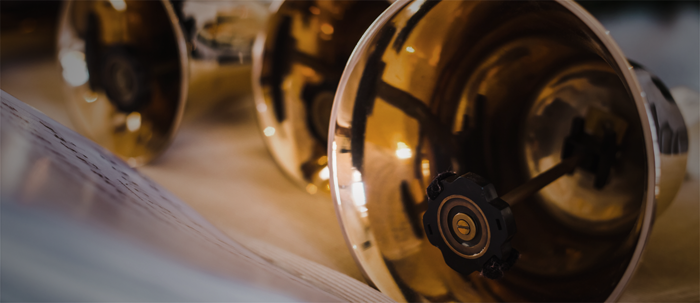
This time of year many of us are faced with the challenge of programming a winter or holiday concert with music that is appropriate for both our students and our community standards. At the same time we look for new and interesting works that present traditional materials at a skill level that fit our students. We all know that not every group will be able to perform Handel’s full Hallelujah Chorus.
Some Things to Consider
- First and foremost; what is your school or district policy regarding holiday programming? If you are not sure, check before you consider music for your concert.
- What is the ability level of your group today and what level can you reasonably get them to by concert time?
- What educational goals do you wish to achieve by programming such music?
- Will the piece or pieces you are considering meet pedagogical goals and criteria?
- Does your choice of music meet state and national standards?
Besides these top-level considerations, you might have more practical ones as well. Is one section particularly strong this year? Perhaps you could select a piece that allows them to really shine. Ryan Thomas shared some great thoughts on this topic in a previous SmartMusic Blog post. Ryan also talks about leveraging the winter concert as a means to get your students where they need to be in the spring…
Looking Ahead
Think about what you want students to play at contest. Programming that music in your holiday concert would certainly give them a head start. Alternately, you may wish to program material that will help them get to these contest goals. Again, check out Ryan’s post for additional details.
Student Interest
Another consideration is whether or not each piece will be engaging enough to sustain your students’ interest through both your rehearsal and your performance.
Mike Gibson is the director of bands at Ridgeview Charter Middle School in Sandy Springs Georgia. He adds,
“We’ve all seen the kids that kill themselves to learn that one cool song in their folders. The crafty director is able to take that energy and transfer the learning into other pieces. This in turn can expand the student’s interests – stretching and challenging their minds to expand into other genre of music.”
One way to increase student investment is to let them pick the music.
Did your blood pressure just rise a little at the thought of that?
You can avoid that by letting them choose from your pre-selected list of titles that meet your other criteria. I shared some details of how I’ve done this in the past in this SmartMusic Blog post.
Audience Interest
Anything we can do to make sure the experience feels inclusive can only help build stronger community. Mike Gibson suggests:
“You have to opportunity to go Multi-Cultural. Music related to Hanukkah and Kwanzaa should be explored. Thinking internationally, what about music from Asia or South America or Africa or the Middle East? Those countries have major celebrations as well, even if you may have to be a little creative with the calendar dates. Ask yourself, ‘Is it wrong to celebrate human celebrations?’”
Balancing Sacred and Secular
Often we feel anxious about making sure we are balancing sacred music from one tradition with music from other traditions – and for good reason. Parents and administrators are always on alert for this type of imbalance. Educational goals can offer an additional justification for programming both secular and sacred repertoire on your holiday concert. You can explain that pieces were chosen based on student development (“this Hanukkah piece emphasizes the harmonic minor scale,”) or to feature a particular section (“Little Drummer Boy features the percussion section”).
Schools where a high degree of collaboration occurs between directors and educators have additional options. For one example, the balance between sacred and secular can be spread across the choir, band, and orchestra, giving each individual group additional flexibility if one concert program leans more this way or that. For another, the opportunity exists to collaborate with history or social studies teachers for cross-cultural tie-ins. (Incidentally, this is a great way to foster relationships with fellow faculty members.) You might work with other teachers to expose kids to music from the time period or culture they are studying. This also helps students internalize the connections between classes and boosts their learning.
As always, cover your bases. Being able to fall back on written district policies – as well as state and national standards – means that your choices of sacred and secular repertoire are “safe.” You may wish to familiarize yourself with NAfME’s position statement on sacred music.
Many districts have a posted policy, like this one from Plano, TX.
Also, don’t hesitate to check with your administration. Confirming beforehand is better than having to put out a firestorm of public opinion afterward. As much as we wish the answer could be “just teach good music,” spending some time balancing sacred and secular repertoire with an eye for pedagogical goals and district policies is a worthwhile investment.
Telling a Tale
One time-tested way to increase audience and student interest is to add the element of a story. Can you find something that tells a story or helps solidify a holiday message? I once had great success programming Stephen Melillo’s “Festival of Lights.” The publisher’s website describes it as “a musical retelling of Chanukah, complete with Syrian invasion, Maccabean defense, the shofar’s call to battle, and the final victory of the eternal light that burned for eight days.”
The music was very dramatic and included shofars (an ancient bugle-like instrument, historically made from a ram’s horn). We had students play the shofars from the back of the auditorium, which added to the drama of the music. The students learned more about the meaning of the holiday from that piece than just being told the story. Best of all, the audience reaction was impressive.
Resources
All of this can be a bit challenging if you do not have access to scores, parts, and audio files. Technology has greatly aided this process. Many online retailers like JWPepper provide perusal scores and audio files. In some cases YouTube can provide opportunities to see and hear performances (and share them with students). SmartMusic also offers easy access to an impressive collection of band, jazz band, orchestra, string orchestra titles, and choral titles.
The Season
To close, I’d like to quote Mike Gibson one last time:
“I think Andy Williams had it right; it is ‘the most wonderful time of the year.’ (Please accept my apologies to songwriters Edward Pola and George Wyle, and for showing my age.)
Every year, my mom and dad turned on classic holiday music by Andy, Bing, and the rest to create an environment promoting cheer and goodwill. I remember visiting my grandparents and standing around the piano as my aunts, uncles, grandparents sang the familiars in four-part harmony. They laughed, hugged, and we ate!
If you were as lucky as me to have powerful family traditions, how could you not think fondly of this time of year? So, I look forward to programming our ‘Winter Holidays Concert’ every year. I really do.
But it’s not these memories that make this time important. What’s important is to help your students to grow, to provide an inclusive atmosphere in your community, and to create similarly powerful memories in the hearts of your students and their families.”
 Ted Scalzo is a veteran teacher of 36 years, including 29 years as the band director at Bay Shore High School in Long Island, NY. His wind and jazz ensembles have received numerous awards. Ted has used Finale to arrange for marching band since version 1.0, and taught music composition/theory and a multimedia class that he designed for Bay Shore students. A fervent advocate of technology in the classroom, Ted was honored as an Apple Distinguished Educator in 2005, was twice appointed to the NYSSMA Music Technology Committee, and teaches a course on music education technology at Hofstra University.
Ted Scalzo is a veteran teacher of 36 years, including 29 years as the band director at Bay Shore High School in Long Island, NY. His wind and jazz ensembles have received numerous awards. Ted has used Finale to arrange for marching band since version 1.0, and taught music composition/theory and a multimedia class that he designed for Bay Shore students. A fervent advocate of technology in the classroom, Ted was honored as an Apple Distinguished Educator in 2005, was twice appointed to the NYSSMA Music Technology Committee, and teaches a course on music education technology at Hofstra University.